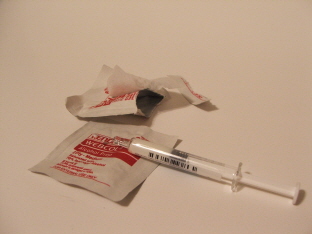 Diabetes is a metabolic disorder that afflicts 5% of the world’s population. People who suffer from diabetes face significant long-term disabilities and complications if they don’t keep their blood glucose under control. Because early diagnosis, treatment and tight control of this chronic condition yeilds good results for the sufferer, researchers have searched for and discovered several short term and long term methods of monitoring blood sugar as well as testing for the condition. (1)
Diabetes is a metabolic disorder that afflicts 5% of the world’s population. People who suffer from diabetes face significant long-term disabilities and complications if they don’t keep their blood glucose under control. Because early diagnosis, treatment and tight control of this chronic condition yeilds good results for the sufferer, researchers have searched for and discovered several short term and long term methods of monitoring blood sugar as well as testing for the condition. (1)
Some physicians follow specific recommendations to test for diabetes in their general patient population. Those who are over 45 and obese should be tested and those younger than 45 and obese should be considered.
Doctors will use several different tests, combine the results of those tests, and determine if a person has diabetes. The first, and simplest, test is the fasting blood sugar test. A small blood sample will be taken at the lab after the patient has had nothing to eat or drink after midnight. Normal blood sugar is between 70-110; considered borderline to 135 and high over 140. (2)
Fasting blood sugar can be affected by factors other than diabetes. If a person is taking a diuretic or steroid it may alter the test. Also, some people who may be considered ‘pre-diabetic’ will also test with high blood sugar when they are ill but their values will return to normal after the illness has subsided.
Most physicians will also request a 2 or 4 hour oral glucose tolerance test (OGTT). During this test the patient arrives at the lab having fasted since midnight. They then drink a high concentration glucose drink. During the next 2 or 4 hours their blood sugar is measured every hour and urine tested every 30 minutes. During a normal test the blood sugar will not go above 110 even though the body has been stressed with a high dose of sugar. If there is diabetes the numbers will be elevated during the test. (3)
Physicians will combine the results of a fasting blood sugar, OGTT, and physical examination and history to make a definitive diagnosis of diabetes.
Once a person has been diagnosed with diabetes it is important to continue to monitor their disease process. This is done through the use of several different blood tests. All diabetics learn to self monitor blood glucose through the use of a glucometer at home. These small machines measure the amount of glucose in the blood by using a small blood sample obtained through a finger stick.
Then once every 3 – 6 months your doctor should order an A1C test to give you and the doctor an overall view of how well the glucose has been controlled in the past three months. The A1C is also called a glycosylated hemoglobin test. The American Diabetes Association recommends that this test is done twice a year for people who are well controlled and more often when blood sugars are not well controlled, if diabetics have other illness (illness affects control of the blood sugar) or when the treatment of the condition is changed. (4)
A serum creatinine test is recommended once a year. This is a simple blood test that helps the doctor to determine how well your kidneys are performing. Serum creatinine is excreted through the kidneys and is a by-product of muscle metabolism. So if your kidneys aren’t working well they won’t excrete as much of the chemical.
A urine microalbumin test also evaluates the health of your kidneys by measuring the amount of protein that leaks through the kidneys into the urine. If your kidneys become damaged the waste products that kidneys normally filter remain in your blood and the protein that normally is in your blood leaks to your kidneys. The test is usually done on a one time fresh urine sample, although your physician may do a quantitative 24 hour study and ask you to collect 24 hours worth of urine.
The last diabetes test that is commonly done are lipid tests to evaluate your low density lipoproteins (LDL) and high density lipoproteins (HDL). Diabetes and heart disease are linked because of the damage that is done to the body from the diabetes and because those with diabetes have a higher risk of developing heart disease.
Doctors use the results of these tests to help determine how much vessel damage may be happening. The American Heart Association and the American Diabetes Association recommend that these tests are done once a year, more often if you are on lipid lowering drugs.
Diabetes tests have improved the way in which diabetes is monitored and treated. Now with vigilant monitoring and treatment patients have a lower risk of high blood pressure, stroke, heart disease and peripheral vascular disease then they once had even 10 years ago.
(1) National Diabetes Information Clearinghouse:
Diagnosis of diabetes
http://diabetes.niddk.nih.gov/dm/pubs/diagnosis/
(2) MayoClinic.com: Diabetes
http://www.mayoclinic.com/health/diabetes/ds01121/dsection=tests-and-diagnosis
(3) MedlinePlus: Glucose Tolerance Test
http://www.nlm.nih.gov/medlineplus/ency/article/003466.htm
(4) American Diabetes Association: Living with Diabetes
http://www.diabetes.org/living-with-diabetes/treatment-and-care/blood-glucose-control/a1c/

Recent Comments